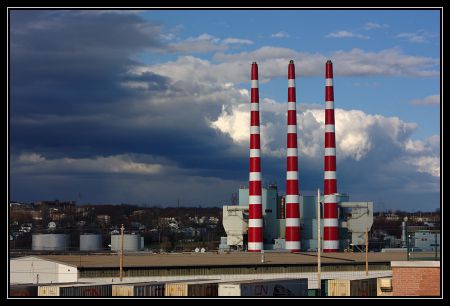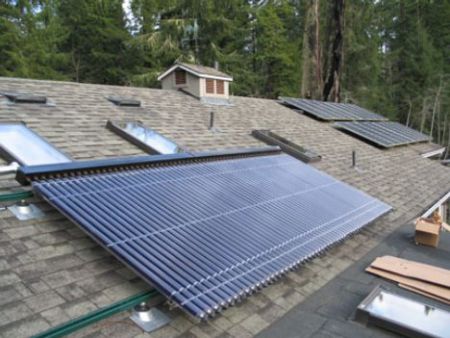Nova Scotia could soon follow in the footsteps of the Alberta tar sands energy boom. But instead of exporting upgraded bitumen, Nova Scotia – the province with the 4th largest amount of greenhouse gas emissions - would play a rather ironic role: that of renewable energy exporter.
“We’re becoming a sort of an electro-state the same way that you can be a petro-state like Alberta where, you know, very few interests really are the dominant players in the society,” says Neal Livingston. “All this hooey we heard about having to be better [grid]-connected to north-eastern North America, when you think about it now, it’s all about our preparation for export.”
Livingston, a filmmaker with 40 titles under his belt, has been a renewable energy practitioner in Cape Breton for 30 years. He owns the Black River brand of renewable energy companies, the holdings of which include a hydro facility and several industrial scale wind turbines in development. This week he delivered a public presentation to a small crowd gathered at The Hub in Halifax.
Livingston has been trying to sound the alarm on Nova Scotia’s energy policy by calling into question the motivations behind the government’s new Renewable Electricity Plan. The recently released plan requires that, by 2025, 40% of the electricity that Nova Scotia Power sells in a given year must come from renewable energy sources.
“When the province legislated 40% renewables… nobody seemed to notice that that wasn’t linked to coal reductions; the coal reductions are separate, and those coal reductions are relatively minor… by 2020 in the range of 8 to 10 per cent.”
Against a backdrop of climate change, fossil fuel price swings, and relentlessly rising energy costs, Livingston paints a disturbing portrait of a provincial energy policy that is shifting away from a dwindling petro-economy, based on rapidly depleting offshore natural gas, towards an electro-economy based on growing exports of renewable electricity to New England.
“It appears that we’re staging up very quickly for Emera to own a transmission line from Nova Scotia to New England, and we’re going to export the renewables, without turning off coal. So that’s rather despicable because… I think that’s not what the public wants, or thinks they’re getting,” says Livingston.
This past week in a joint press conference, the governments of Nova Scotia and Newfoundland announced that renewable electricity from the Lower Churchill hydro mega-project in Labrador will be connected via sub-sea cable to Newfoundland, carried across the province, and then connected via another sub-sea cable to Cape Breton.
Emera is investing $2 billion dollars in the project, and will own 20% of the electricity that is produced, or 8% of Nova Scotia’s needs. The company can then sell the electricity to New England in order to meet the 40% renewable energy goal.
“If we’re going to bring power in from Newfoundland, here’s a once-in-a-lifetime opportunity to turn off, let’s say, 5 out of 7 of our coal fired power plants… and that’s not the plan. So effectively we’re allowing the next 50 years to 100 years of our energy supply to be planned around a private company and its profit, and that’s not coming with significant coal reductions in the short term.”
Livingston points to the new biomass plant in Port Hawkesbury and the new tidal power projects in the Bay of Fundy as further examples of Nova Scotia’s electricity future being planned around large corporate interests.
“What we’re doing is throwing shovel-loads and bucket-loads of public money at tidal power, and who’s doing the tidal power work? Well, it’s Minas Pulp and Paper, [which is owned by] the richest family in the province, and Emera, which is the largest company.”
But there is a decentralized, home-scaled approach to renewable energy development that returns ownership of our energy production into the hands of the public, says Livingston.
“The technologies can all be on our homes and buildings, and that means that in step one you put solar hot air and solar hot water [heaters] on all your buildings. On a societal level, if we went and put 100,000 of these on in the next five years on Nova Scotia homes and buildings, we’d massively add a bunch of employment and we’d make a big carbon reduction, and we’d have those benefits land from the energy savings in your pocket,” he says.
“Then the following five years you can go with the same crews of people who are trained, and you can put photovoltaics… on people’s homes, and effectively all our homes and buildings could become carbon-neutral at that point.”
The future of Nova Scotia's energy system boils down to a simple question, says Livingston.
“Do you end up with one or two large corporate interests owning all of the energy supply in Nova Scotia, or do you end up with all of us owning this?”
**CORRECTION:
The Renewable Electricity Plan sets a target of 40% renewable energy by 2020, not 2025. This represents a aspiration only, and has not yet been legislated.





